Template:Header ProDon
Introduction
The custom reports tool allows you to create reports from a search conducted previously.
Firstly, it is important to know that:
- It is possible to create a custom report from all the management grids in which the report icon
 is active (blue).
is active (blue).
- A report is always attached to a precise management grid. For instance, if it is created in the "Transaction management", it doesn't appear in the "Client management".
- The fields available for the creation of a report are the same as the ones in the corresponding management grid (columns).
- It is possible to include summaries to the reports only from the "Client management" and "Analysis & History".
- Each management grid contains files (e.g. the client file in the "Client management" grid) and it is possible to generate an existing report from each of these files. However, it is not possible to create a new one.
Managing the Reports Available
First of all, go in the management proper to the type of report you want to create, modify or delete.
Click on the  button.
button.
|
This window opens.
|
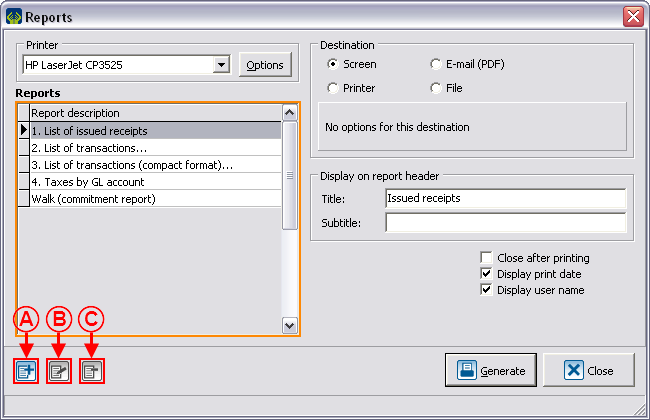
|
|
A: The  button allows you to create a new report. button allows you to create a new report.
|
B: The  button allows you to modify a report. button allows you to modify a report.
|
|
C: The  button allows you to delete a report. button allows you to delete a report.
|
NOTE: The reports provided by Logilys are not modifiable nor deletable.
|
Creation of a Custom Report
Go to the management proper to the type of report you want to create.
Conduct a search by criterion using the search bar, so that the management grid corresponds to what should be found on the report.
Once the management grid corresponds to what should be found on the report, click on the  button.
button.
To create a new report, click on the  button.
button.
|
This window opens.
|
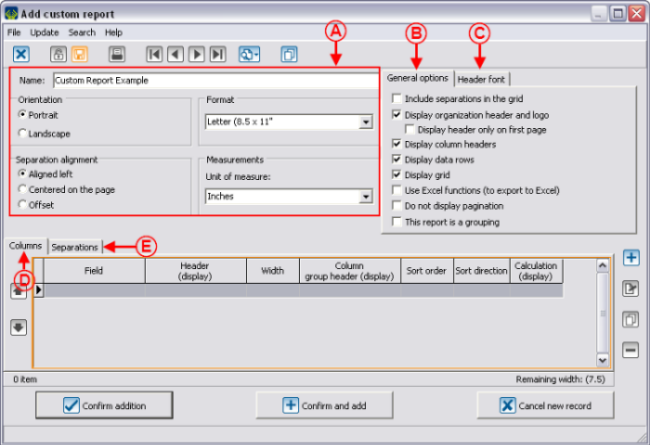
|
|
A: This section allows you to configure the visual options.
|
B: The "General options" tab allows you to configure the general option of the custom report.
|
|
C: The "Header font" tab allows you to choose the header font of the report.
|
D: The "Columns" tab allows you to add columns to the report.
|
|
E: The "Separations" tab allows you to add separations to the report.
|
|
Configuration of the Visual Options
|
For all the following examples concerning the visual configuration, refer to the "Examples of Visual options" section.
|
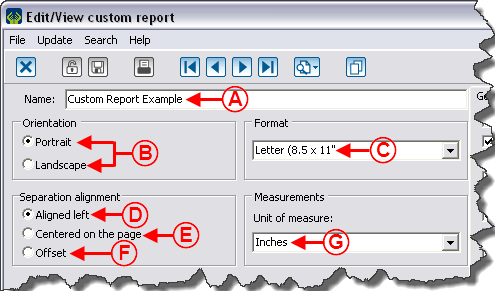
|
|
A: Allows you to name the custom report.
|
B: Allows you to decide whether the report will be generated in "Portrait" or "Landscape" orientation.
|
|
C: Allows you to choose on which paper format the report will be generated (e.g. 8,5 X 11", 8,5 X 14", etc.).
|
D: This option allows you to align the separations to the left. To view an example of left alignment, see letter B.
|
|
E: This option allows you to centre the separations alignment. To view an example of centred separation, see letter G.
|
F: This option allows you to offset the separations alignment. To view an example of offset separation, see letter I.
|
|
G: Allows you to choose the unit of measurement to be used for the width of the report columns.
|
|
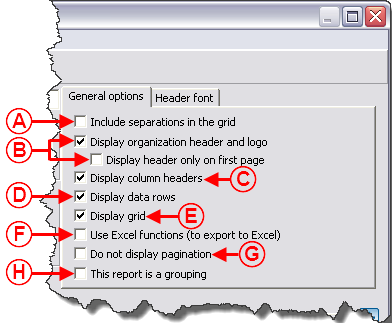
|
|
A: Allows you to include separations in the grid. To view an example of separation above the grid, see letter B. To view an example of separation in the grid, see letter G.
|
B: Displays the header and the logo of the organization on the first page only or on all the pages of the report. To view an example of header, see letter A.
|
|
C: Displays the header of the columns. To view an example of column header, see letter C.
|
D: Displays the data lines. To view an example of data lines, see letter D.
|
|
E: Displays the grid. To view an example of report with a grid, see letter E. To view an example of report without a grid, see letter J.
|
F: Uncheck this box if Excel sends an error message during the exportation.
|
|
G: If the box is checked, the pagination will be on the report. If the box is not checked, the pagination will not be displayed.
|
H: Activates the grouping option on the report. To view an example of report without the grouping option, see letter F. To view an example of report with the grouping function, see letter H. For more information concerning the grouping option, click here.
|
Examples of Visual Options
First Example
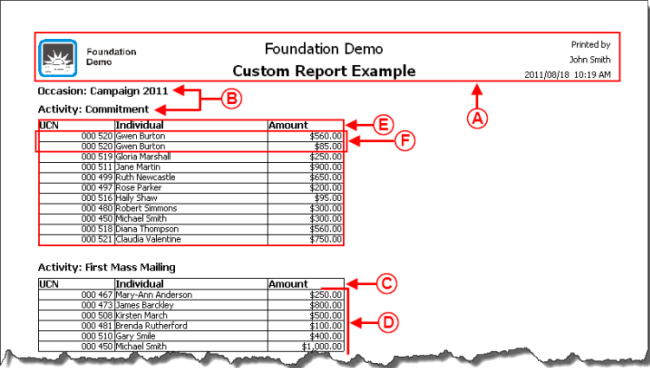
|
|
A: It is the header including the logo of the organization.
|
B: Example of report when the separations are aligned to the left and above the grid.
|
|
C: This line is a column header.
|
D: These lines are the data lines.
|
|
E: Example of report when the option "Display grid" is checked.
|
F: Example of report when the grouping option is not checked. If it had been checked, Mrs.Gwen Burton would have appeared only once and her two donations would be added. See the example in H for a grouped report. For more information concerning the grouping option, click here.
|
Second Example
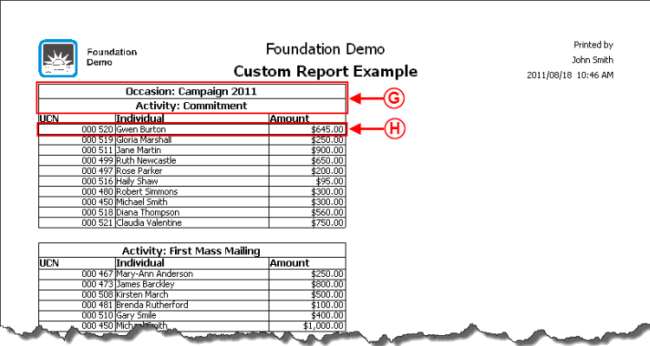
|
|
G: Example of report where the separations are centred and in the grid.
|
H: Example of report where the grouping option is checked. If it had not been checked, Mrs. Gwen Burton would have appeared twice in the grid, since she has made two donations for the same activity. See the example in F for a report that is not grouped. For more information concerning the grouping option, click here.
|
Third Example
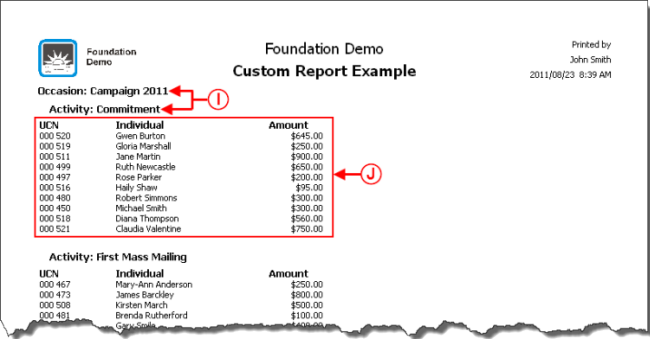
|
|
I: Example of report where the separations are offset.
|
J: Example of report where the option "Display grid" is not checked.
|
Adding Columns to the Report
|
To add a column to a report, click on the  button in the "Columns" tab that is at the bottom of the "Add custom report" window. button in the "Columns" tab that is at the bottom of the "Add custom report" window.
|
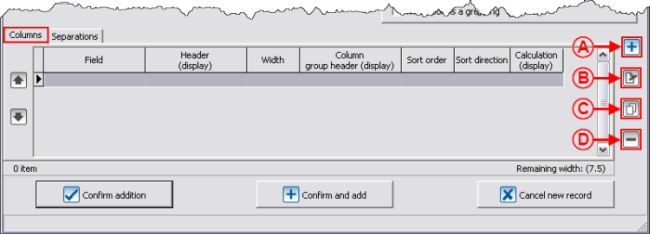
|
|
A: Allows you to add a new column to the report.
|
B: Allows you to modify an existing column.
|
|
C: Allows you to duplicate an existing column.
|
D: Allows you to delete a column from the report.
|
|
After clicking on the  button, this window opens. button, this window opens.
|
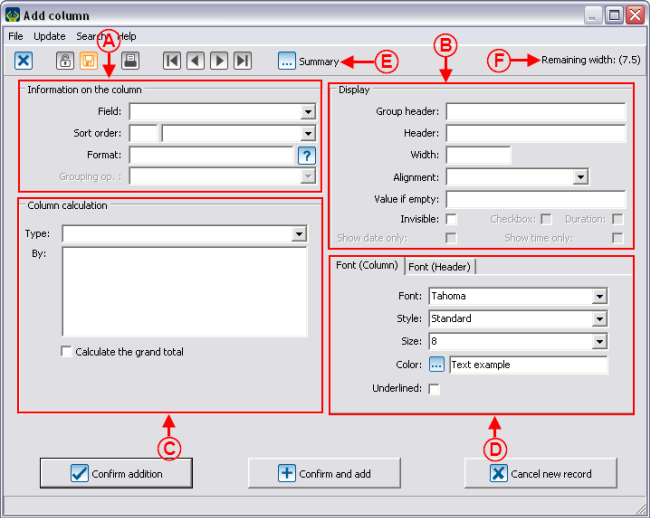
|
|
A: The section "Information on the column" allows you to specify the source of information to use and to configure information as well.
|
B: The section "Display" allows you to modify the presentation of the column in the report.
|
|
C: The section "Column calculation" allows you to do a mathematical operation in order to enter the result at the bottom of a column (e.g. the donations average by person, the total of the donations for an activity, the total of the donations for an occasion, etc.).
|
D: The "Font (Column)" tab allows you to choose the font to be used for the data lines.
The "Font (Header)" allows you to choose the font to be used in the header line of the column.
|
|
E: The " Summary" button is a shortcut to the "Summary management", if you want to quickly create a summary that will be available at the very bottom of the list of fields in A. Summary" button is a shortcut to the "Summary management", if you want to quickly create a summary that will be available at the very bottom of the list of fields in A.
|
F: The "Remaining width" displays the available space on the report.
NOTE: If the measurement unit had been defined in centimetres in the visual options configuration, the "Remaining width" would be written in centimetres.
|
Information on the Column
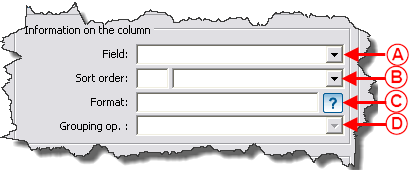
|
|
A: Allows you to choose the fields that will be present in the report.
It is also possible to choose, using the drop-down list, a summary. The list of summaries can be found at th very bottom of the drop-down list.
The following options are also available: "Configurable value", "conditional value" and "Calculation function", and are the three first choices of the drop-down list.
|
|
B: Allows you to decide on the order in which the information is displayed. In the first box, you have to specify the sorting priority and in the second box, you have to specify it is an ascending or descending order
Example: The sorting must first be in alphabetical order of client (1-ascending) and then in ascending order of UCN (2-ascending), so that:
If two clients have the same name and that one or the other has two transactionsto his or her name, both transactions from the same client will automatically follow each other:
UCN Client Amount
- 004 321 Smith, Matthew $300
- 004 542 Smith, Matthew $200
- 004542 Smith, Matthew $150
If the order by UCN has not been determined, the clients could have been mixed up:
UCN Client Amount
- 004 542 Smith, Matthew $200
- 004 321 Smith, Matthew $300
- 004 542 Smith, Matthew $150
|
|
C: Allows you to modify the presentation of a piece of data in the column.
The  button contains the indications on the configuration of format. button contains the indications on the configuration of format.
Example: The default format of the UCN is "000 000" and the UCN is "001 234". If the format were changed to "#", the UCN would become "1234".
Another example: The date format is "yyyy/mm/dd" and the date entered is "2011/07/28". If the format were changed to "mmmm", the date would become "July".
|
|
D: Allows you to choose a mathematical operation whereof the result has to be displayed in the columns of the data lines. This menu is active only if the option "This report is a grouping" is checked in the report main screen.
For more information on the grouping option and on the types of operations available, click here.
|
Display
|
For all the following examples concerning display, refer to the "Examples" section.
|
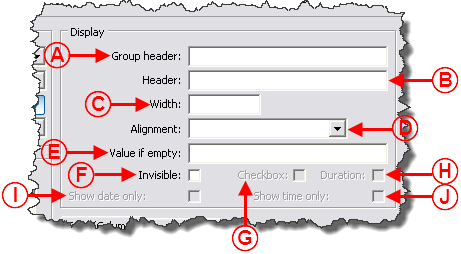
|
|
A: Allows you to indicate a reference to be displayed above the column header in order to identify groups of columns. To view an example of group header, see letter A.
|
|
B: Allows you to change the name of the column header on the report. By default, the name of the header is the same one as the field's. To view an example of header name different from the field's, see letter B.
|
|
C: Allows you to specify the space the column must occupy on the report. The unit of measurement depends on the one that was chosen in the visual options configuration. To view an example of column width, see letter C.
|
|
|
|
|
|
|
|
|
|
|
|
|
|
|
Example of Display
Calculation on Column
Example of Calculation on Column
Adding Separations to the Report
Examples of Separations
Configurable Value
Example of Configurable Value
Conditional Value
Example of Report with a Conditional Value
Calculation Function
Example of the "Calculation Function" Field
Using the Option "This report is a grouping"
Example of an Onscreen Search
Result of the Onscreen Search
Document name: ProDon:Custom Reports
 is active (blue).
is active (blue). 
![]() button.
button.
![]() button.
button.









